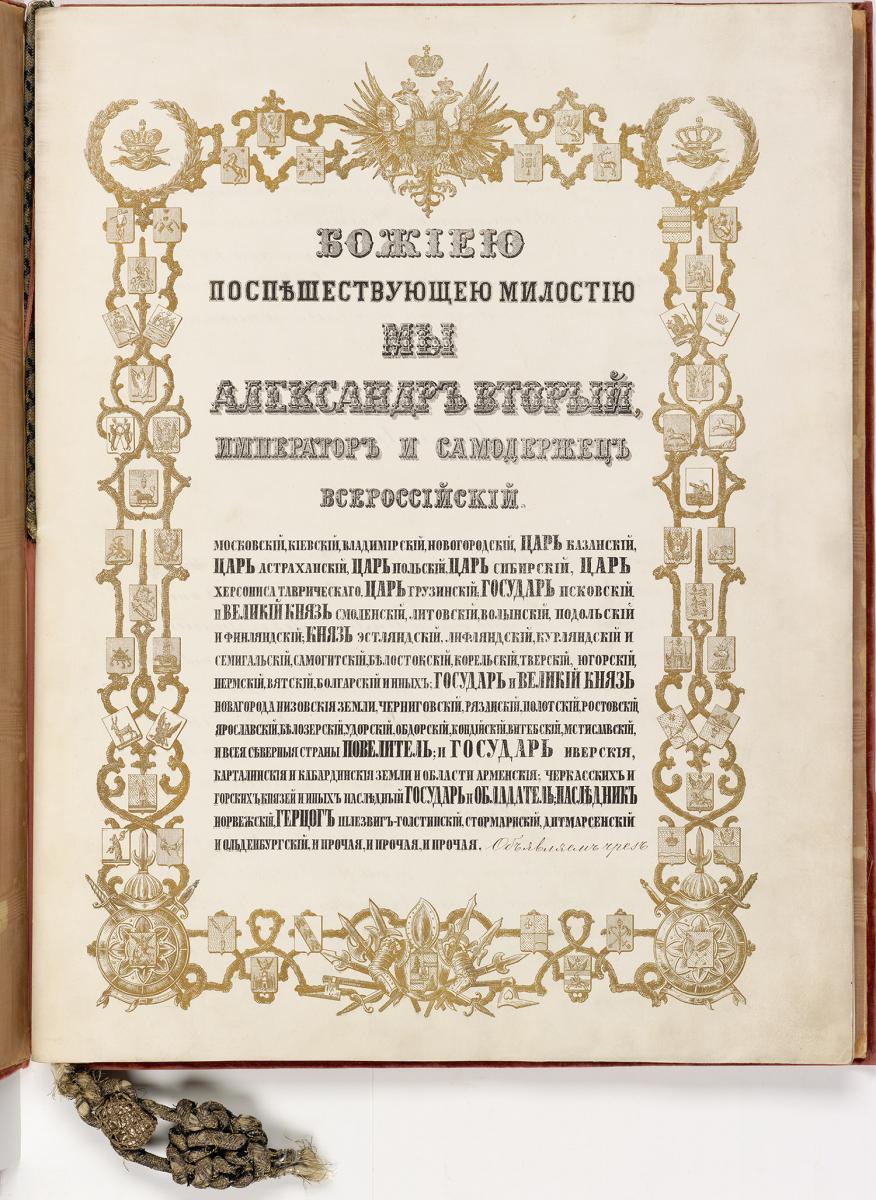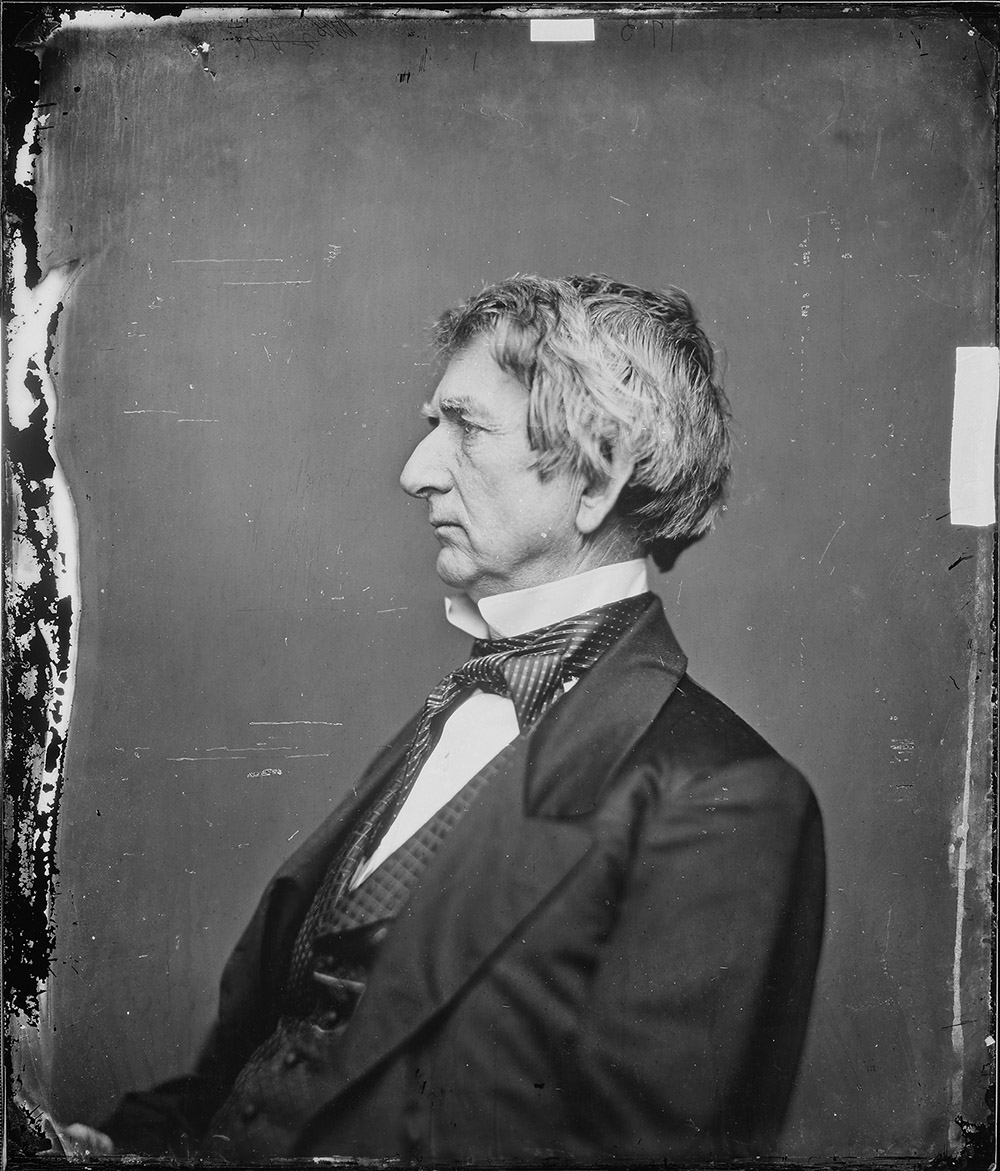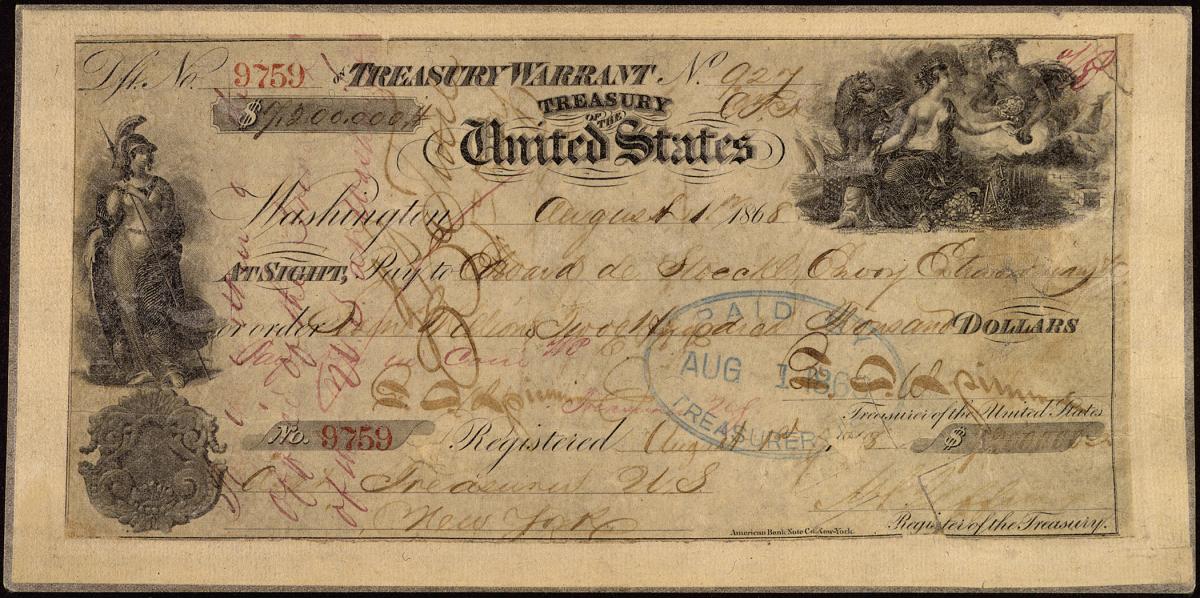
Seward's Bargain: The Alaska Purchase from Russia
Winter 1994, Vol. 26, No. 4
By Milton O. Gustafson
When Russia's provocative nationalist Vladimir Zhirinovsky announced last year [1993] that he wanted Alaska back, it inspired cartoonist Jim Borgman of the Cincinnati Inquirer to depict a worried President Clinton asking the National Archives to find the receipt for the purchase of Alaska. The cartoon was a reminder that in the middle of the nineteenth century there was a potential for conflict because Alaska was the place where Russia's movement east across Siberia and to North America met the westward expansion of the United States. Russia's sale of Alaska to the United States after the Civil War, a story told in documents in the National Archives, eliminated Alaska as a source of conflict between the two world powers.
Russia's interest in Alaska dates from 1741, when explorer Vitus Bering reached the North American mainland. In 1799 the tsar established the Russian-American Company and granted it complete political and economic control over the area claimed, and the company established a trading post at Fort Ross, just north of San Francisco. Great Britain's claim to the area around the Columbia River led the United States to negotiate separate treaties with Great Britain in 1818 (joint occupancy of Oregon Country) and Russia in 1824 (setting the southern boundary of Russian America).
In the expansionist years of the 1840s and 1850s, American interest in the north Pacific grew, and Russia began to think of selling Alaska to the United States. During the Crimean War between Britain and Russia, Alaska was neutralized, but Russia realized it might lose Alaska to Great Britain in any future war, and the Russian-American Company required heavy government subsidies from a depleted Russian treasury. In 1856 the Russian minister to the United States, Edouard de Stoeckl, recommended selling Alaska to the United States. Some advisers to the tsar agreed and even suggested a price, $5.6 million. Senator William Gwin of California, who had constituents embroiled in a contract controversy with the Russian-American Company, talked confidentially to Stoeckl and President James Buchanan and suggested $5 million as a fair price. Stoeckl was instructed to seek a higher price but to wait until after the company's charter expired in 1862. Senator Gwin also recommended delay until the election of a new President; the country would not support any proposal from the unpopular Buchanan, and any hint of northern expansion would become embroiled in sectional politics and opposed by slave-state senators.
The pre–Civil War negotiations failed because Russia was not ready to sell and the U.S. offer was not enough. After the war, expansionist spirit in the United States diminished, but Russia was ready to sell.
In December 1866, Stoeckl, in Russia for the first time in seven years, met Tsar Alexander and his leading advisers. It was decided that Stoeckl would return to the United States and use his diplomatic skills to induce the U.S. government to make an offer to buy Russian America for not less than $5 million. Stoeckl was a popular diplomat in Washington, especially after marrying an American, Elizabeth Howard from Massachusetts, but after fifteen years in the United States he hoped that successful negotiation for the sale of Russian America would bring him financial reward and promotion to a better diplomatic post in Europe.
The principal negotiator Stoeckl would face was Secretary of State William Seward. After serving as state senator, governor of New York, and U.S. senator, Seward was a Republican party candidate for President in 1860 but lost the nomination to Abraham Lincoln. Lincoln asked him to be secretary of state, and Seward served with distinction throughout the Civil War. Seward had a broad vision of commercial expansion of the United States, particularly in China and the Pacific, and as early as 1864 he had suggested to the Russian government that talks about Alaska "would be beneficial to us, and by no means unprofitable to Russia."
Stoeckl returned to Washington, met with Seward at the new State Department building on March 11, 1867, and wasted no time with diplomatic maneuvering; he said he was authorized to receive an offer for Russian America. At a second meeting, on Thursday, March 14, Seward announced that he had consulted with President Andrew Johnson, who was "not inclined" toward the purchase but was nevertheless willing to accept Seward's judgment. Seward said he was interested but needed to consult the cabinet. Stoeckl offered to promote the sale by talking to some of his friends in the Senate and House, but Seward insisted on secrecy until the cabinet was agreed. They discussed the price. Seward suggested $5 million, or "perhaps $5.5 million, but no more." Since Seward had raised his own bid, Stoeckl decided to remain silent and suggested in a cable to Russia that he would try to get $6.5 million or at least $6 million. By Friday, March 15, Seward had a draft treaty prepared for the cabinet discussion and asked for authority to pay Russia $7 million for Alaska. There was little interest, no comment from President Johnson, and no cabinet disagreement.
When they met again, Seward told Stoeckl that the cabinet contained opposition, and he could offer no more than $6.5 million. But Seward also wanted to buy all of the property of the Russian-American Company, and he wanted a treaty before Congress adjourned in April. Stoeckl asked for $7 million and Seward agreed. Although both sides started with a $5 million negotiating price, Stoeckl's silence and Seward's desire resulted in a $2 million increase for Russia. On March 25 Seward asked Stoeckl to cable the proposed agreement to St. Petersburg; if the reply came within six days, the treaty could be signed and confirmed by the Senate before its adjournment.
On Friday, March 29, Stoeckl received the cable approving the deal. That evening he walked over to Seward's home on Lafayette Square to give him the news. Seward's son, Assistant Secretary of State Frederick Seward, later reported the conversation:
"Tomorrow, if you like, I will come to the department, and we can enter upon the treaty."
Seward replied, "Why wait until tomorrow, Mr. Stoeckl? Let us make the treaty tonight."
Before proceeding, however, Seward decided it was time to tell Senator Charles Sumner, chairman of the Senate Foreign Relations Committee, about the proposed treaty. Sumner's support in the committee and also on the Senate floor was essential—two-thirds of the Senate would have to advise and consent to the treaty before it could be ratified. Seward asked Frederick Seward to find Sumner and deliver a letter to him: "Can you come to my home this evening? I have a matter of public business in regard to which it is desirable that I should confer with you at once." Sumner walked across Lafayette Square to Seward's home and learned that there was a treaty about to be signed for the sale of Russian America to the United States. Sumner listened, asked questions but offered no opinions, and went home. That evening Sumner sent a note to Seward suggesting that after Congress adjourned its legislative session as scheduled at noon on the following day, Saturday, March 30, "the Senate would be glad to proceed at once with Executive business" and thus promptly consider the treaty.
Secretary Seward and two clerks hurried to the State Department building, the newly erected Washington City Orphan Asylum Building on the southeast corner of Fourteenth and S Streets, NW.1 When Stoeckl arrived at the State Department, he and Seward haggled over details. Russia wanted payment to be made in London within ten months. An ice contract between the Russian-American Company and the city of San Francisco threatened to complicate matters. Seward noted that Congress could not possibly appropriate funds until its next session, in 1868; Stoeckl agreed to payment in Washington instead of London; and Seward added $200,000 to the sale price. The treaty was written in English and French (the Russian diplomatic language), texts were compared, two copies of the treaty were engrossed, and Seward and Stoeckl signed both copies of the treaty at 4 a.m. on Saturday, March 30, 1867.
Article I of the treaty provided for Russia to cede its territories in America, with defined boundaries. Article II provided for the transfer of property, except for property individually owned and for property owned by the Greek Orthodox Church, and for the transfer of "government archives, papers, and documents . . . which may be now existing there." That is why the records of the Russian-American Company are now in the National Archives (Record Group 261). Article III provided for the inhabitants (except for the "uncivilized native tribes") to either return to Russia within three years or stay there and become American citizens. Article IV provided for Russia to appoint agents for the convenient transfer of the property, but the cession was to be considered "complete and absolute" upon the exchange of ratifications. Article V provided for the withdrawal of Russian troops as soon as practicable following the exchange of ratifications. Article VI provided for the United States to pay, within ten months of the exchange of ratifications, $7.2 million in gold for free and clear title to the ceded territory. Article VII provided for the exchange of ratifications to take place within three months, or sooner if practicable.
Seward, hoping for rapid Senate approval of the treaty, wasted no time. By 10 a.m. that Saturday morning he met with the cabinet and President Johnson. Both Johnson and Seward signed the presidential proclamation calling the Senate into special session on Monday, April 1. Johnson also submitted a formal message to the Senate requesting its advice and consent to the treaty, and the Senate referred it to the Foreign Relations Committee. Seward lined up newspaper support (only Horace Greeley's New York Tribune opposed the treaty) and wined and dined influential senators. The key was Chairman Charles Sumner of Massachusetts. Sumner was upset because Seward had failed to consult with senators in the negotiating process and refused to consider postponing treaty approval, but he overcame his objections. Drawing upon the resources of the Smithsonian Institution and the Library of Congress, Sumner quickly became an expert on Russian America. Instead of simply not opposing the treaty, he became its most ardent advocate. After four closed-door committee sessions over a ten-day period, Sumner finally secured committee approval on Monday morning, April 8. When the full Senate met in executive session that afternoon, Sumner spoke for three hours from a single sheet of notes, providing an exhaustive summary of the argument favoring the purchase. Later published as the "Speech of Hon. Charles Sumner, of Massachusetts, on the Cession of Russian America to the United States," the original handwritten draft of the manuscript filled 225 pages. It was during that speech that Sumner first used the word "Alaska" to describe Russian America. On the following day, after six more hours of debate, the full Senate finally approved the treaty by a thirty-seven to two vote.
Tsar Alexander ratified the treaty on May 3, 1867. Stoeckl received word on May 15 that the ratified treaty was on its way to the United States, and he notified Seward. Even though President Johnson did not formally ratify the treaty until May 28, 1867, Stoeckl agreed on May 22 to Seward's request to immediately send American troops to Alaska. Finally, at Seward's insistence, ratifications were exchanged on June 20, 1867, in Washington, two weeks earlier than planned.
The commissioners named to effect the exchange were Brig. Gen. Lovell H. Rousseau and Capt. Alexis Peshchurov. They went to San Francisco and then sailed to Sitka for the formal exchange on October 18, 1867. Although the ceremony started smoothly, there were complications. The Russian flag got stuck, and could not be lowered. Russian officials prepared a formal protocol listing government property (but not private property) to be transferred to the United States, plus a map showing the locations of the buildings and churches. A formal exchange document was signed by Rousseau and Peshchurov. In the end, Alaska belonged to the United States, by treaty as well as by possession. As yet, however, no money had been paid.
When the new session of Congress met in December 1867, President Johnson's message asked for an appropriation to pay for Alaska and a law to establish civil government there. Several private claims against Russia threatened to complicate the appropriation process. The impeachment of President Johnson and his trial in the Senate further delayed business past the April 20 deadline specified in the treaty. Worried about the delay, Stoeckl promised to pay $20,000 in gold to Robert J. Walker, former Mississippi senator and treasury secretary, to lobby for the appropriation. Finally, on July 14, the House voted 113 to 43, with 44 abstentions, to approve the appropriation of $7.2 million for the purchase of Alaska. The Senate approved a modified version, and so a conference committee had to reconcile the versions and resubmit it to both houses again. It finally passed on July 27, 1868.
In the mid-nineteenth century, U.S. government procedures for disbursing $7.2 million in gold appropriated by Congress for the purchase of Alaska were little different than procedures for disbursing $150 for the purchase of a desk. On July 28 Secretary of State Seward signed a requisition for a warrant, #4217, for $7.2 million in gold from the Treasury Department. On July 29, L. L. Smith, the first auditor of the treasury, established an account, #165,615, and signed a report approving the payment of $7.2 million to the Emperor of Russia and sent it to the comptroller of the treasury. The comptroller and the register of the Treasury Department, the government's chief bookkeeping official, then certified the report. The register of the treasury wrote an order on the U.S. treasurer, an appropriation warrant. The treasurer, in turn, authorized the transfer of the funds to a departmental disbursing agent, who was accountable for the proper use of the money. On August 1 the agent wrote a draft in that amount, a pay warrant, payable to Edward de Stoeckl. Stoeckl endorsed the draft over to Riggs Bank with instructions to Riggs to pay the money to Russia's bank for foreign accounts, the London office of Baring Brothers and Company. Riggs, who charged a fee of $3,600 for his services, sent only $7,035,000 to the Baring office in New York. Stoeckl authorized Riggs to pay Robert J. Walker $26,000 in gold for his lobbying services. What happened to the remaining $139,000?
A single newspaper reporter, Uriah H. Painter, Washington correspondent for the Philadelphia Inquirer and New York Sun, stirred the pot. Painter's articles opposed both the treaty and the appropriation, but reportedly he offered to change sides and support the appropriation for a price (the offer was rejected). Painter discovered that Robert J. Walker went to New York, presumably to cash a check drawn on Riggs's New York bank, and thieves robbed him of $16,000 in gold treasury notes. Although quickly apprehended, only $11,000 was recovered, and Walker refused to press charges.
In December 1868 the House of Representatives decided to investigate. Francis Spinner, the treasurer of the United States, George Riggs of Riggs Bank, Secretary of State Seward, Robert Walker, and eight other lobbyists and journalists all testified, but the final conclusion of the House Committee on Public Expenditures was "barren of affirmative or satisfactorily negative results." Stoeckl had returned to Russia, and the chargé d'affaires, Waldemar Bodisco, refused to testify. Russian archives reveal no names, but Stoeckl secretly reported that he had disbursed almost $200,000. It seems likely that some of the money was paid to other lobbyists, besides Walker, and to congressmen. Since $1 in gold was worth $1.50 in greenbacks, paying people with greenbacks added to the confusion evident in the House report.
There are two contemporary accounts of payments. President Andrew Johnson wrote an undated note stating that Seward told him that John W. Forney, the editor of the Daily Morning Chronicle, received $30,000 in gold, that Walker and Stanton received $20,000, Banks got $8,000, and Stevens got $10,000. John Bigelow, former minister to France and a friend of Seward, reported in his diary that Seward told him that ten members of Congress got $10,000, Walker got $20,000, Stanton got $10,000, J. W. Forney got $20,000, and "$10,000 more were to be given to poor Thad Stevens, but no one would undertake to give that to him so I undertook it myself. The poor fellow died and I have it now."2
A few days after the House committee issued its report, the Johnson administration ended, and William Seward resigned as secretary of state. In his retirement, Seward traveled across the country in a railroad "hotel" car furnished by George Pullman. After reaching San Francisco, he sailed to Sitka, Alaska, and there, in a speech on August 12, 1869, he predicted that with its scenery, weather, and resources, one day Alaska would become a state in the Union. Ninety years later his prediction came true.
Notes
© 1994 by Milton O. Gustafson
1. The State Department occupied this building until July 1875; in 1927 the Orphan Asylum moved, and the building was enlarged and became the Merchandise Building; later it was razed, and the site is now occupied by townhouses.
2. Professor Ronald J. Jenson of George Mason University, author of The Alaska Purchase and Russian American Relations (1975), concludes that the money was distributed as follows:
Payments in Gold
$7,035,000 to Baring Brothers
26,000 to Robert J. Walker and Frederick P. Stanton
3,000 to D. C. Forney
1,000 to M. M. Noah
10,000 for the cost of the treaty telegram to St. Petersburg
30,000 to John Forney
21,667 to Stoeckl and Bodisco
73,333 converted to greenbacks (see below)
__________
$7,200,000 Total in Gold
Payments in Greenbacks
$100,000 to ten congressmen (including Banks)
$10,000 to Stevens (kept by Seward because Stevens died)
________
$110,000 Total in greenbacks = $73,333 in gold


